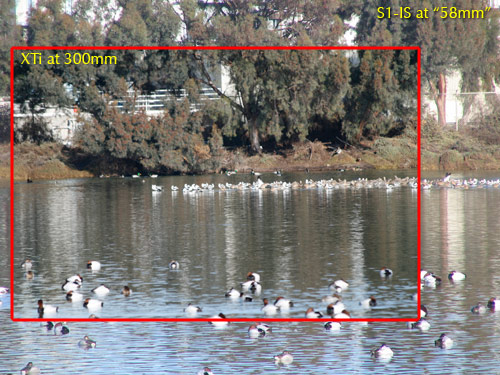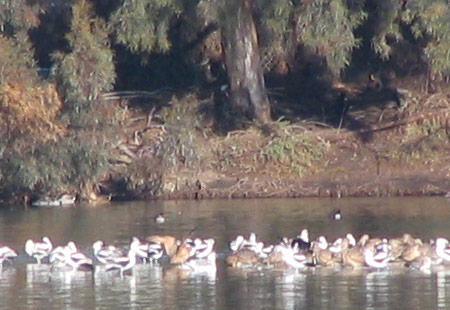S1-IS’s 10x Zoom vs. Digital Rebel XTi’s 300mm Zoom
One of the things I wanted to know before buying the 10.1-megapixel XTi was, how did its 300mm zoom compare with the 10x zoom on my older 3.2-megapixel PowerShot S1-IS? Would the new, much more expensive camera deliver any better magnification?
The numbers were not translatable, apparently; no one that I could find had a direct x-to-mm chart showing equivalencies. But there had to be some way to compare the two. As I went ahead and bought the XTi anyway, I was able to simply shoot comparable photos and see what the differences were.
I should note that I was not taking any care to match the f-stop, exposure times, white-balance or metering, so the image colors and other qualities may seem different between the two cameras; this is simply due to my lack of attention to certain details, rather than any actual differences in the cameras.
If you inspect a camera’s image in Photoshop (or another image editing program), you can get information on what settings the camera was set to when the photo was taken–what shutter speed, aperture, and focal length, for example. This is called “EXIF” data. With the digital SLR, the focal length (effectively, the “zoom”) is directly proportional to the “mm” rating for the magnification. For example, my short lens is 28mm ~ 105mm, and my long lens is 70mm to 300mm. That’s exactly how the focal length reads in the EXIF data. 50mm is considered a standard focal length for normal photos.
With the point-and-shoot S1-IS, however, the focal length is reported as ranging from 5.8mm to 58mm, 5.8mm being the standard wide-angle “non-zoom” setting, and 58mm being the “10x” zoom. Even when using the same “mm” measuring system, the numbers are obviously not equivalent to what the DSLR’s use. So instead, let’s see what the photos look like side-by-side. Since there is not enough room on your screen, let alone my blog frame, to show entire photos, these images have been reduced, but in ways to show equivalency.
First, here are two images, showing the S1-IS at 5.8mm (max zoom-out) and my 28 ~ 105mm lens on the XTi at 28mm:
 S1-IS
S1-IS
 XTi
XTi
As you can see, the XTi’s 28mm was a bit more “zoomed in” than the S1-IS’s 5.8mm. Of course, the XTi has far more megapixels; the S1-IS image is 2048 pixels wide, while the XTi’s is 3888. If we reduce the S1-IS’s image to be proportionate to the XTi’s in pixels, it would look like this:
 S1-IS
S1-IS
Compare that to the image just above it, and you can see how much more information the XTi captures.
Okay, now for the maximum zoom. On the S1-IS, max zoom is “10x,” or “58mm.” For the lens I bought for the XTi, the max zoom is 300mm. I took photos with both cameras of some birds just below the far shoreline. Here are the whole images superimposed.

This one is a bit confusing to sort out. The XTi’s image looks smaller, but that just means that it is zoomed in more. I had to reduce the XTi’s image that much to match the area in the S1-IS image. The XTi’s image is still 90% wider than the S1-IS’s, so clearly it contains a great deal more detail.
For a slightly better idea, this time I’ll show a small portion of the above images–a 450-pixel-wide cropped part of each image, showing what the exact pixels caught for each camera:
 S1-IS
S1-IS
 XTi
XTi
You’ll notice that the XTi’s image is much more “zoomed in”; this is a combination of the slightly greater actual zoom (about 20% more), and the increased detail from having more resolution.
You might also think that the S1-IS has better sharpness. However, there are two factors playing into this: first, I believe that the XTi was dealing with a smaller depth of field, and my inexpert focusing caused a different part of the image to be in focus; and second, as the birds and other objects in the S1-IS’s picture seem smaller, they also seem sharper. However, they are not. If we enlarge the S1-IS’s image so it shows the birds approximately at the same size at the XTi’s image, we get this:
 S1-IS
S1-IS
 XTi
XTi
This makes it quite clear that we’re getting a lot more detail with the XTi. Since I had to blow up the S1-IS image about 250% to get it to match the size of the XTi’s, I would guess that the 300mm zoom on the XTi is approximately worth a “25x” zoom for a point-and-shoot.
Now, I do have a telephoto converter for my S1-IS, though I forgot to bring it with me on this trip. However, the telephoto lens only adds 60%, for a total 16x zoom–not to mention that the quality is not all that great. With the 1.6x telephoto converter on the S1-IS, at full zoom, there is a lot of purple fringing and other artifacts that I have yet to see on the XTi at full zoom.
So, in the end, the XTi with a 300mm lens has more than twice the magnification power of my old S1-IS–if you include the extra boost given by the extra megapixels.
I’ll have to try another test on another day to see if I can work out the possible problems with focusing and other image settings, to give an even closer comparison. However, this will do for now.

Great posting. A few things worth noting…
Some cameras include, in the EXIF data, their “35mm focal length equivalent”. I have a Casio that does exactly that; it reports its OWN focal length and then the 35mm equivalent. My S2-IS doesn’t do this, so I’m sure your S1-IS also doesn’t.
Your XTi also has its own focal length equivalent. The XTi’s multiplier is 1.6 (according to this page at dpreview http://www.dpreview.com/reviews/specs/Canon/canon_eos400d.asp) so shooting with the 28-105 wide open, which would be “28 mm” focal length on a traditional 35mm sized frame, you’re actually getting the equivalent of a 44.8mm focal length in 35mm.
Your last comparison- where you show the level of actual detail difference between the XTi and the S1-IS- is a very good one. What it demonstrates is why the XTi is superior (and also why a digital SLR with an even bigger image sensor would be better still); if you want to zoom and crop in on a part of a picture, you retain a ton more detail if your original image size has a lot more pixels in it.
The same thing holds true if you don’t zoom and crop but instead just print the picture in a bigger size. If you framed the same shot with both cameras and then printed it out as a big blowup, say 11X14 or 16X20, the XTi’s image should be greatly superior to the S1’s.
This assumes, of course, that in the process of ordering the print you give the printer (whether your own or commercial) the entire image file. Many online printing solutions (such as Costco’s excellent and relatively inexpensive standard prints in 4X6 size) use software that will compress the original photo’s resolution downward unless you specifically tell it to not do that.
They do this to save on bandwidth. Since most folks uploading a picture are just going to print it out as a 4X6, they don’t need all that resolution and hence don’t want to pay for the bandwidth charges to get it into their machine.
What this all means in real life is this: People often overbuy. When someone can get a pretty decent picture out of a smaller (say 3 or 4 megapixel) camera, why buy a unit that gets 8 or 10 megapixels? If pretty much all they do is use the pictures online, or in a little scrapbook, or to print out standard 4X6 photos, they don’t need the latest/greatest 80 megapixel camera.
On the other hand, if they want to be able to zoom/crop in with great detail (like your last picture with the ducks) or if they plan on printing their photos into 8X10 or greater sizes, they’re better served with the fancier camera with a lot more resolution.
Of course, the other part to this is that the one with the big-time resolution will probably also have superior autofocus, a higher quality lens, much faster start-up time, more frames per second, better white balancing and metering, etc.
Well, for a real test, I should choose a stationary, vertical subject, and make sure that the focus is good. It would be interesting to use the RAW format files as well. That would allow a full test of the differences, and allow for easier comparison.
As for printing photos, I usually use my own printer. In Japan, however, many electronics shops have printing booths–you put in your flash memory card and order a photo right there. I should try it sometime.